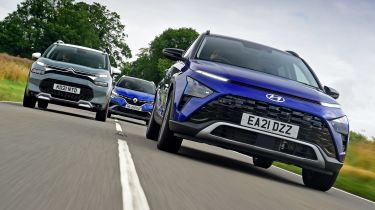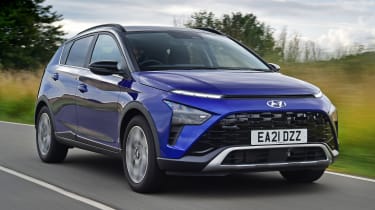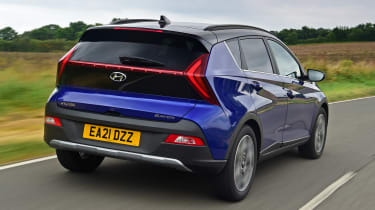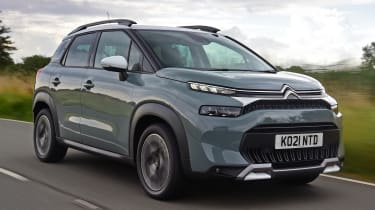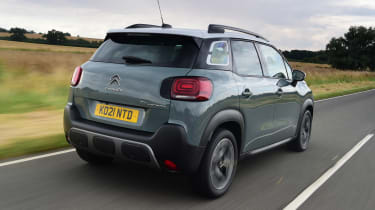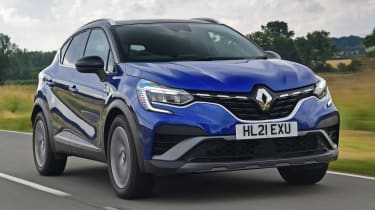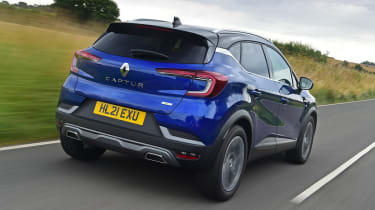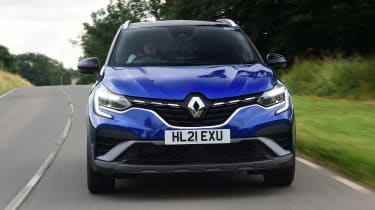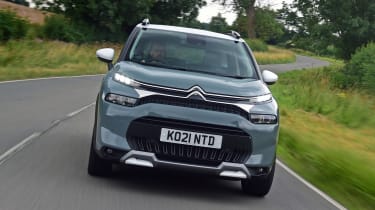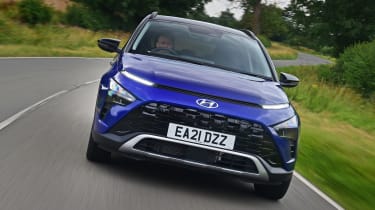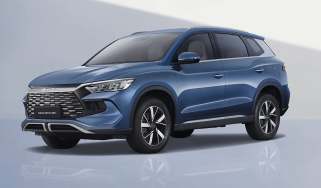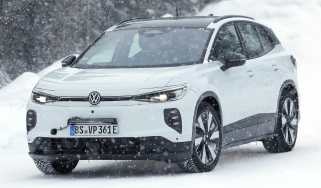Hyundai Bayon vs Citroen C3 Aircross vs Renault Captur
Small SUVs are eating into sales of the hatchbacks they’re based on. The Hyundai Bayon is the latest arrival, and we test it against two current Auto Express champions in the Citroen C3 Aircross and Renault Captur
A quick dive into the latest new-car sales charts suggests it’ll be only a matter of time before the small SUV becomes the most popular body style in the UK. That means they’d surpass the popularity of the humble superminis on which they are based, but a quick look at the numbers show they stack up.
With its Puma and Fiesta, Ford produces two of the most popular models in each class, and 2021’s figures up to August show that 20,853 Pumas have been sold. That’s enough for fifth overall, and only 2,500 units behind the Fiesta. In July alone, the SUV outsold its hatchback relative.
Therefore it’s no surprise that brands continue to flood the segment with even more choice. The newest model to enter the ring is the Hyundai Bayon. The Korean brand has been on a roll over the past year or two, scooping various class wins in our Car of the Year awards, plus overall victory for the brilliant Ioniq 5 EV.
But the Bayon has a very tough fight on its hands here, because both of its rivals are Auto Express award winners themselves. The Renault Captur is our reigning Compact SUV of the Year for the second year running; a great all-rounder that’s competitively priced, it makes a very strong case for itself in this class.
Used - available now

2026 BMW
i4
51,795 milesAutomaticElectric
Cash £24,398
2022 BMW
i3
33,824 milesAutomaticElectric
Cash £12,327
2020 Hyundai
i10
54,869 milesManualPetrol1.0L
Cash £5,961
2024 Audi
e-tron GT
18,147 milesAutomaticElectric
Cash £38,570Then there’s the Citroen C3 Aircross – our current Used Car of the Year. However, here it’s the newly facelifted model we’re testing that features subtle improvements across the board. Are the Citroen’s tweaks enough to topple the Renault? Or does the new Hyundai have the measure of both rivals?
Hyundai Bayon
| Model: | Hyundai Bayon 1.0 T-Gdi MHEV iMT Ultimate |
| Price: | £25,045 |
| Engine: | 1.0-litre 3cyl turbo, 118bhp |
| 0-62mph: | 10.4 seconds |
| Test economy: | 53.3mpg/11.7mpl |
| CO2: | 132g/km |
| Annual road tax: | £155 |
Prices for the Bayon start from £20,295, although here we have the top-spec Ultimate version paired with the most powerful mild-hybrid engine. In this trim, it comes to £25,045, while the ‘Intense Blue’ paintwork adds an extra £550.
Design & engineering
You could be excused for looking at the Bayon with a little confusion. Not because of the dramatic angular looks, but because anyone who is familiar with Hyundai’s current line-up might wonder how it’s any different from a Kona. The pair are almost identical in length, although the Bayon is ever so slightly narrower and lower, and from some angles looks more like a supermini estate than a small SUV. The crucial difference is in the underpinnings. While the Kona uses technology adapted from the i30, the Bayon is based on the more compact, newer and lighter i20.
On average, the Bayon weighs about 145kg less than an equivalent Kona with the same engine. Here, that motor is a 1.0-litre turbo three-cylinder with mild-hybrid tech. This recoups kinetic energy that would otherwise be wasted when slowing down, and then uses it to give a small boost under acceleration to take the load off the engine. The six-speed manual gearbox is paired with an electrically actuated clutch, which can decouple in gear so that the engine can switch off when coasting to save even more fuel. A dual-clutch automatic is also offered. Power outputs of 99bhp and 118bhp are available, and we’re trying the more powerful version here.
In many larger classes, Hyundai has vaulted itself to the top of the segment when it comes to perceived quality. Not so in the Bayon. Here, the plastics feel hard everywhere they’re within easy reach, and they don’t look very pleasant from a distance. The great in-car tech that we’ve come to expect from Hyundai is the car’s saving grace, but otherwise this cabin feels a step down from both the Citroen and especially the Renault.
Driving
While cabin quality is a disappointment, the Bayon’s driving experience is right on the mark. Alongside the French competition, the Bayon’s suspension set-up is considerably more taut, but the ride quality is by no means uncomfortable by the general class standard. Bumps are dealt with swiftly, while noises and knocks from the suspension are well isolated from the cabin. For a relatively small car, motorway refinement and stability are impressive.
On twistier roads, the Bayon is the sharpest of these three to drive. It corners keenly, the balance is safe and neutral, and there’s decent grip. The steering is the most precise of this bunch at higher speeds, but is also quite light, which is really helpful around town. It’s a nippy and easy car to drive in urban areas.
If we were to level one minor criticism, it’s that the driving position feels barely any higher than the i20 supermini’s, so you don’t really benefit from the more lofty SUV-inspired feel that both the Citroen and Renault provide.
One of the first things you notice out on the road is the Bayon’s clutch. The pedal is very light, and one side effect of the electrical actuation is that there isn’t a specific change in pressure when the biting point is reached. Its position is consistent though, so you’ll soon get used to it. The smooth, torquey engine is refined regardless of how hard it’s driven. At 10.4 seconds, the Bayon’s 0-62mph time is just a matter of tenths down on the C3 Aircross, but a more significant distance behind the Captur.
Practicality
Each of these three cars has its strengths when it comes to storing people and things. In the case of the Bayon, it’s rear legroom; it offers more than either the Captur or the C3 Aircross. Conversely, it also has the tightest headroom of the three; most adults will still just about cope, but by the standards of the class it’s among the more cramped.
When it comes to storage, the deep glovebox impresses, but the cupholders are a little shallow. The door bins front and rear curve outwards so that they can hold a large bottle, while ahead of the gearlever is a wide, flat shelf for a smartphone. This features a couple of USB ports and a 12-volt socket, plus wireless charging in higher trim levels. Passengers in the back share a single USB port.
At 334 litres, the Bayon has the smallest boot here, and it lacks its rivals’ sliding rear bench. Fold the seat backs down and total volume grows to 1,205 litres. That’s the lowest number again – 70 litres and 84 litres behind the Renault and Citroen respectively.
Ownership
When it comes to your satisfaction of new car brands, a mid-table finish was still enough for Hyundai to outscore both Citroen and Renault in the 2021 Driver Power manufacturer ratings.
The Korean firm ranked 16th out of 29 brands; Renault finished 20th and Citroen a lowly 28th. That’s all the more disappointing for Citroen when you consider that Peugeot – with which it shares so much technology – took a respectable 11th overall.
Running costs
The Bayon is the most expensive car of this particular trio, but it does compensate for this slightly by having the strongest residual values. After three years, this trim and engine combination is predicted to retain 49 per cent of its original retail price, which just edges the Captur by 0.7 per cent, and is a decent jump ahead of the C3 Aircross, at 43.7 per cent.
The Citroen holds its strongest residuals lower down its range. Not only is the C-Series trim with the same PureTech petrol engine tested here offered for £17,225, but it also holds 48.5 per cent of its value.
Testers’ notes: “Many new cars need a clutch press before starting, and others (mainly autos) a dab of brake. Weirdly, the Bayon needs both before the engine will fire.”
Citroen C3 Aircross
| Model: | Citroen C3 Aircross PureTech 110 Shine Plus |
| Price: | £21,225 |
| Engine: | 1.2-litre 3cyl turbo, 108bhp |
| 0-62mph: | 10.1 seconds |
| WLTP economy: | 51.5mpg/11.3mpl |
| CO2: | 136g/km |
| Annual road tax: | £155 |
The C3 Aircross has consistently impressed us thanks to its competitive price – and the facelifted car maintains that tradition. This top-spec Shine Plus model, at £21,500 before options, is comfortably the cheapest car on test.
Design & engineering
The C3 Aircross was first introduced in 2015, making it the oldest car of this bunch, and in such a fast-moving class, it’s one of the oldest in the segment.
However, the range has been refreshed for 2021, which most notably has introduced a new front end whose X-shaped lighting arrangement aligns its look more closely with the latest C4. Citroen expanded the number of colour options and combinations available to buyers, too; a range of paint finishes can be paired with either a black, white or matching roof, resulting in a total of 70 combinations.
While the revised styling has introduced a more angular fascia, the rest of the car remains soft and curvy, going against the fashionable standard of designers to make even modest family hatchbacks look aggressive.
For the latest round of updates, Citroen introduced its ‘advanced comfort’ seats. A range of different foam materials are applied selectively throughout, which Citroen claims helps to optimise support. They’re right: step inside and it feels like only a bare minimum of adjustment is needed to find an ideal driving position.
Slightly less impressive is the handbrake lever. While it’s not unusual in this class to still have a mechanical control rather than a switch, the button’s position on top of the lever (rather than the end) is awkward to use. It feels like Citroen is trying to be contrary for the sake of it. The large glass area and short bonnet make the C3 Aircross very easy to place on the road, though.
Driving
The exterior designers have opted for a soft approach for the looks, and it’s one that has been followed by the chassis engineers, too.
The Citroen’s suspension is by far the softest here, and combined with 17-inch wheels and tyres with generous sidewalls, the C3 Aircross is among the most comfortable cars to drive in the segment. Factor in the new seats, and it’s an incredibly relaxing vehicle by small-car standards. In fact, with better soundproofing against road noise and suspension knocks, comfort levels would be up with some executive cars.
While you might suspect that it’s the body roll that the soft springs introduce – and there’s certainly the most lean in this trio – that’s not what stops the C3 Aircross from being fun to drive. Instead, that’s the fault of the steering which, although light and easy to use around town, is vague; and the gearshift, which feels similarly loose and rubbery. Well judged control weights and a smooth ride needn’t be mutually exclusive, but the former is absent here.
The three-cylinder 1.2-litre PureTech engine gives strong performance, though, in most conditions. It vibrates more than the Bayon’s smaller engine, however, a feeling which transmits itself through the steering wheel and the pedals.
Practicality
At 1,637mm tall, the C3 Aircross stands 61mm higher than the Captur, and towers 137mm above the Bayon. So even though it’s shortest car here, there’s still plenty of space inside. Rear headroom is the best on test, and while legroom is just the tightest, there’s very little in it. As with the Captur, the C3 Aircross has a sliding rear bench that can be brought forward to increase boot space. Unlike the Renault, here the seat splits 60:40, so you can slide only part of it forward if you prefer, further increasing its versatility.
The boot’s 410-litre volume compares really well against the Hyundai’s (334 litres) and the Renault’s (404 litres). Thanks to the sliding bench which can advance 150mm, that figure can increase to 520 litres, but in its furthest forward position, legroom becomes very tight, especially when taller adults are sat up front. Another slight criticism is the boot being framed by quite a deep bumper, which makes it a little more awkward to load larger items inside.
Storage spaces are reasonable, but some are more useful than others. The shelf above the glovebox is handy, but the glovebox is very small. The door pockets are deep, but we’re yet to figure out what the small shelf below the starter button could hold. The sliding cover for the cubby between the front seats is a neat touch, and rear passengers get a 12-volt socket.
Ownership
Citroen offers a five-year/100,000- mile warranty with the C3 Aircross, on one condition. That level of cover is only available if you place your order online via a PCP finance deal; should you go through the traditional channels via your local dealer, the warranty is reduced to three years and 60,000 miles.
Regardless of how you place an order for the Renault or the Hyundai, you get a five-year deal as standard. Renault’s package matches the 100,000 miles of its French rival, while Hyundai’s warranty covers drivers over an unlimited distance.
Running costs
While the Citroen has the highest emissions of this trio, the low retail price means that it’s still the cheapest car to run for company car users. It sits in the 31 per cent Benefit-in-Kind bracket, and will cost standard-rate income tax payers £1,316 per year in deductions.
The lowest emissions of this group slot the Hyundai into the 28 per cent band, but the highest retail price here means that its BiK rate comes to £1,390. The Renault’s 30 per cent rating, meanwhile, results in the highest figure here, at £1,502.
Testers’ notes: “High-set daytime running lights are super-bright, but they obscure the indicators that are next to them. Citroen needs to add a dimming function.”
Renault Captur
| Model: | Renault Captur TC3 140 R.S. Line |
| Price: | £25,505 |
| Engine: | 1.3-litre 4cyl turbo, 138bhp |
| 0-62mph: | 10.3 seconds |
| WLTP economy: | 47.9mpg/10.5mpl |
| CO2: | 121g/km |
| Annual road tax: | £145 |
Our favourite compact SUV of the moment is facing its sternest challenge yet in this company. The model in our photos is the R.S. Line trim paired with the TCe 140 petrol engine and automatic gearbox, but for the purposes of this test we’ll be matching its specs to the rivals here. That means we’re basing our numbers on the manual version, which before options is priced at £25,300.
Design & engineering
The Captur is underpinned by the CMF-B platform, that’s shared with the Clio supermini and the Nissan Juke. The structure is more rigid and safer than the tech used before, and can also accommodate both plug-in and standard hybrid powertrains; the former is already part of the Captur line-up, while the latter will be joining soon.
Renault claims that the new, stronger body structure and a better use of soundproofing materials have improved refinement compared with the old car. At 70mph, the manufacturer claims the latest version is two decibels quieter.
Earlier this year, Renault tweaked the Captur’s engine line-up. The 1.3-litre four-cylinder turbo petrol, co-developed with Mercedes, was previously available with a choice of 128bhp or 153bhp; these have both been dropped in favour of a single 138bhp version of the same unit. Driving the front wheels only (like its rivals here) it can be matched to either a six-speed manual gearbox or a seven-speed automatic.
In auto models, the gear selector sits on a panel that floats above the centre console. This is boxed in for manual models, but the raised position still means that the gearlever is well placed. The rest of the cabin ranks among the very best in the segment. The piano keys on the dashboard, the knurled finish to the climate controls and the clever use of soft- touch materials mean that the Captur feels like a premium product, when some manufacturers have made the penny-pinching a little too obvious.
Driving
Out on the road, there’s an old-school French feel in the way the Captur combines a smooth ride and a stable, neutral chassis. It’s not fun to drive as such – look to a Hyundai Bayon, or particularly the Ford Puma for thrills – but it’s more comfortable over bumps than either, despite our R.S. Line car riding on the largest 18-inch alloys available in the range. As a package, the Captur is one of the best in the class. The steering is light and precise, and that high driving position gives a great view of the road ahead.
The engine is a fine unit, too. The extra cylinder makes it smoother than the three-cylinder competition, and the 260Nm peak torque is much higher than either the Bayon or the C3 Aircross.
While it feels the most flexible in everyday driving, the Captur’s greater kerbweight means that there’s very little in this trio against the clock – all accelerate from 0-62mph in just over 10 seconds. Once up to speed, road and wind noise are as well suppressed in the Renault as anything in the class.
The manual gearshift is okay (none of the models in this test offers a very slick change), but an overly springy clutch pedal takes the shine off what is otherwise a fine drive.
Practicality
As with its ride and handling, the Captur strikes a balance between its two rivals here when it comes to rear-seat space. Legroom is barely a few millimeters tighter than in the Bayon and better than in the C3 Aircross, but it pips the Hyundai for headroom and lags behind the Citroen. Tech fans in the back are best catered for here, though, because Capturs not only come with two USB ports, but also a 12-volt socket. They’re mounted below a set of air vents, which again is a unique feature in this company, and ideal for keeping kids cool on a hot day.
Isofix points in the Renault are hidden behind zipped covers, which means they’re a little more fiddly to access than in the Citroen, which has a gap in the seat padding around each fixing mount.
At 404 litres, boot space is almost on a par with the C3 Aircross, and comfortably more spacious than in the Bayon. The opening is wide, and with the false floor in its raised position, the load lip is almost completely level with the main area. This continues when you fold the seats down, which increases the overall volume to 1,275 litres – again very sightly smaller than the Citroen. None of these cars’ boots comes with features like 12-volt sockets or tethering hooks, although all benefit from an adjustable floor. The Renault also has a couple of small hooks on which to hang shopping bags.
Ownership
When the Captur was tested by Euro NCAP in 2019, it achieved the maximum five star score; the 96 per cent rating for adult occupant protection was particularly impressive. The extensive safety tech includes adaptive cruise control, blind-spot detection, lane-keep assist and traffic-sign recognition.
The C3 Aircross also earned five stars, but it achieved this score against less-stringent testing standards back in 2015. The Bayon has yet to be tested.
Running costs
In the real world, there’s little to choose among this trio for fuel consumption, Officially, the Hyundai is the most frugal, topping 53.3mpg in the WLTP tests. The Citroen is next, at 51.5mpg, and the larger, more powerful Renault achieves 47.9mpg. Match those figures over 10,000 miles and you’ll pay £1,385 for the Hyundai, £1,433 for the Citroen and £1,541 for the Renault.
However, the Renault claws a small portion of that difference back with servicing costs. A three-year package, at £499, undercuts the Hyundai’s by just £60, but is £182 cheaper than the Citroen’s.
Testers' notes: “Renault has persevered with a credit card-style key for almost 20 years now, but it’s still a neat touch to include a little slot to hold it between the front seats.”
Verdict
First place: Renault Captur
The Renault Captur is our award-winning compact SUV for many reasons, all of which are emphatically proven in this test. It takes the best aspects of space and (almost) the comfort of the Citroen, the smart driving manners and technology of the Hyundai, and combines them with the finest cabin, the smoothest engine and, if you take advantage of Renault’s current finance deal, an extremely competitive price, too.
Second place: Citroen C3 Aircross
It’s the oldest car here, but there’s still plenty to like about the C3 Aircross. The soft styling and smooth ride are pretty much unique virtues in the segment, and the car scores very strongly on comfort and space. Prices are incredibly keen at the lower end of the range, which is where we’d aim for. With that in mind, it’s little more than a decent infotainment system away from matching the Captur.
Third place: Hyundai Bayon
The Hyundai Bayon is another great effort from the Korean brand overall; it’s just not quite talented enough to beat two of the very best models in this segment. In some ways it’s the best car here: its technology is brilliant, there’s loads of kit, and the handling and engine refinement are impressive. But the interior feels very cheap, which is a let down when the Bayon is also the most expensive car to buy of this trio.
Other options in this category...
Ford Puma
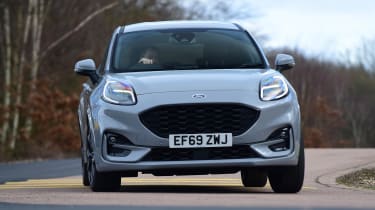
- Model: Ford Puma 1.0 E’Boost 125 MHEV ST-Line X
- Price: £24,345
- Engine: 1.0-litre 3cyl, 123bhp
The UK’s most popular model in this class is also the best to drive. A huge boot offers impressive practicality, while a strong range of mild-hybrid turbo petrol engines and a comprehensive kit list come at a competitive price.
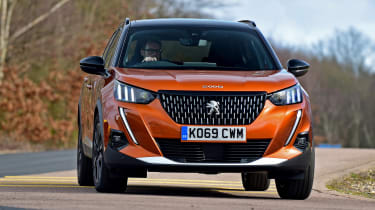
- Model: Peugeot 2008 PureTech 130 GT
- Price: £26,515
- Engine: 1.2-litre 3cyl, 128bhp
The only car in this class with an interior finished to a higher standard than the Captur, the handsome 2008 rides and handles well, too. The e-2008 EV has a 200-mile real-world range, but ICE cars are expensive compared with the most-talented rivals.
Figures
| Renault Captur TCe 140 R.S. Line | Citroen C3 Aircross PureTech 110 Shine Plus | Hyundai Bayon 1.0 T-Gdi MHEV Ultimate | |
| On the road price/total as tested | £25,300/£25,900 | £21,500/£22,020 | £25,045/£25,595 |
| Residual value (after 3yrs/36,000) | £12,225/48.3% | £9,400/43.7% | £12,270/49.0% |
| Depreciation | £13,075 | £12,100 | £12,775 |
| Annual tax liability std/higher rate | £1,502/£3,003 | £1,316/£2,632 | £1,390/£2,780 |
| Annual fuel cost (12k/20k miles) | £1,541/£2,568 | £1,433/£2,389 | £1,385/£2,308 |
| Insurance group/quote/VED | 15/£547/£155 | 14/£498/£155 | 15/£503/£145 |
| Cost of 1st/2nd/3rd service | £499 (3 years) | £681 (3 years) | 15/£503/£145 |
| Length/wheelbase | 4,227/2,639mm | 4,155/2,604mm | 4,180/2,580mm |
| Height/width | 1,576/1,797mm | 1,637/1,765mm | 1,500/1,775mm |
| Engine | 4cyl in/1,333cc | 3cyl in/1,199cc | 3cyl in/998cc |
| Peak power/revs | 138/5,500 bhp/rpm | 108/5,500 bhp/rpm | 118/6,000 bhp/rpm |
| Peak torque/revs | 260/1,750 Nm/rpm | 205/1,750 Nm/rpm | 200/2000 Nm/rpm |
| Transmission | Six-speed man/fwd | Six-speed man/fwd | Six-spd man/fwd |
| Fuel tank capacity/spare wheel | 45 litres/£250 | 45 litres/option | 40 litres/repair kit |
| Boot capacity (seats up/down) | 404/1,275 litres | 410/1,289 litres | 334/1,205 litres |
| Kerbweight/payload/towing weight | 1,352/447/1,200kg | 1,179/616/840kg | 1,120/540/1,110kg |
| Turning circle | 11.1 metres | 10.8 metres | 10.4 metres |
| Basic warranty (miles)/recovery | 5yrs (100,000)/3yrs | 3yrs (60,000)/1yr | 5yrs (unlimited)/1yr |
| Driver Power manufacturer/dealer pos. | 20th/22nd | 28th/8th | 16th/16th |
| NCAP: Adult/child/ped./assist/stars | 96/83/75/74/5 (2019) | 85/82/64/60/5 (2015) | N/A |
| 0-62mph/top speed | 10.3 secs/122mph | 10.1 secs/114mph | 10.4 secs/115mph |
| WLTP economy/range | 47.9mpg/474 miles | 51.5mpg/510 miles | 53.3mpg/469 miles |
| WLTP combined | 10.5mpl | 11.3mpl | 11.7mpl |
| Claimed CO2/tax bracket | 132g/km/30% | 136g/km/31% | 121g/km/28% |
| Airbags/Isofix/parking sensors/cam. | Six/yes/F&R/yes | Six/yes/F&R/yes | Six/yes/F&R/yes |
| Auto box/lane keep/blindspot/AEB | £1,600/yes/no/yes | £1,580/no/£200**/y | £750/yes/yes/yes |
| Climate control/cruise control | Yes/adaptive | Yes/yes | Yes/yes |
| Leather/heated seats | No/yes | £900/no | No/yes |
| Met paint/LED lights | £600/yes | £520/yes | £0/yes |
| Keyless entry & go/powered tailgate | Yes/no | Yes/no | Yes/no |
| Sat-nav/digital dashboard | Yes/yes | Yes/no | Yes/yes |
| DAB/connected services | Yes/yes | Yes/yes | Yes/yes |
| Wireless charging | Optional* | No | Yes |
| Apple CarPlay/Android Auto | Yes/yes | Yes/yes | Yes/yes |
